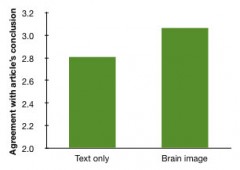Persuade with Pictures
 A picture may be worth MORE than a thousand words in some cases. A new study shows that text is more credible when accompanied by photos, even when the photos don’t support the point of the text!
A picture may be worth MORE than a thousand words in some cases. A new study shows that text is more credible when accompanied by photos, even when the photos don’t support the point of the text!
Researchers at the Victoria University of Wellington in New Zealand showed that statements about a celebrity being alive or dead were judged to be accurate more often when they were accompanied by photos of that celebrity. While the celebrity was, of course, alive when photographed, the scientists found that the photos didn’t produce and “alive bias.” A statement that the celebrity was dead was also judged as true more often when accompanied by the photos, showing that the photos produced a “truth bias.” (Paper: Nonprobative photographs (or words) inflate truthiness.)
One experiment substituted verbal descriptions for the photographs, and those also produced a truth bias.
The key factor seems to be that the photos provided specific information about the individual – they showed them engaged in their profession. A politician might be standing in front of a bank of microphones, for example.
Even general knowledge claims were enhanced by photos. The statement, “Turtles are deaf,” was judged to be true more often when accompanied by a photo that shows a turtle but in no way demonstrates their hearing ability or lack thereof.
Beware of Brain Scans
 A specialized case of this phenomenon was illustrated several years ago when research studies shown to neuroscientists were shown to be more credible when accompanied by fMRI brain scan photos, even though the scans were not related to the conclusion of the paper. (See Brain Image Bias.)
A specialized case of this phenomenon was illustrated several years ago when research studies shown to neuroscientists were shown to be more credible when accompanied by fMRI brain scan photos, even though the scans were not related to the conclusion of the paper. (See Brain Image Bias.)
If even specialized information like neuroscience research is rendered more credible by irrelevant imagery, it’s no surprise that the New Zealand researchers found it to be true of more general content.
Influence with Images & Text
The Neuromarketing takeaway from this body of work is that if you want to be credible, you should accompany your statements with photos and, perhaps, descriptive text. Clearly, if the imagery directly supports your claims, so much the better. But, even if such photos don’t exist, you should still include relevant images. For example, a claim of “easy to use” would be hard to directly prove by a photo, but an image of a person using the product (presumably not grimacing or looking perplexed!) could still make the claim more believable.
Text Too? While marketers should always be wary of adding non-essential text to ads or websites, the research also shows that descriptive text made an assertion more credible even when the text didn’t directly support the claim. So, it’s possible that adding a paragraph of text describing the process used to manufacture the product could make the “easy to use” claim more believable.
Don’t use random stock photos only vaguely related to the message you are trying to convey. The persuasive photos in the study were specific, even though they didn’t actually have any value as proof of the statement. And, as always, don’t add photos or text willy-nilly assuming they will boost credibility and conversion – test either or both against a control!
